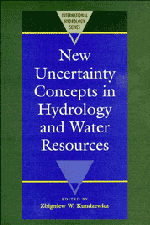Book contents
- Frontmatter
- Contents
- List of Authors
- Preface
- I INTRODUCTION
- II FACETS OF UNCERTAINTY
- 1 Bayesian relative information measure – a tool for analyzing the outputs of general circulation models
- 2 A stochastic weather generator using atmospheric circulation patterns and its use to evaluate climate change effects
- 3 Hydrological uncertainty – floods of Lake Eyre
- 4 Some aspects of hydrological design under non-stationarity
- 5 New plotting position rule for flood records considering historical data and palaeologic information
- III NOVEL APPROACHES TO UNCERTAINTY: FRACTALS, FUZZY SETS AND PATTERN RECOGNITION, NON-PARAMETRIC METHODS
- IV RANDOM FIELDS
- V TIME SERIES AND STOCHASTIC PROCESSES
- VI RISK, RELIABILITY AND RELATED CRITERIA
2 - A stochastic weather generator using atmospheric circulation patterns and its use to evaluate climate change effects
Published online by Cambridge University Press: 07 May 2010
- Frontmatter
- Contents
- List of Authors
- Preface
- I INTRODUCTION
- II FACETS OF UNCERTAINTY
- 1 Bayesian relative information measure – a tool for analyzing the outputs of general circulation models
- 2 A stochastic weather generator using atmospheric circulation patterns and its use to evaluate climate change effects
- 3 Hydrological uncertainty – floods of Lake Eyre
- 4 Some aspects of hydrological design under non-stationarity
- 5 New plotting position rule for flood records considering historical data and palaeologic information
- III NOVEL APPROACHES TO UNCERTAINTY: FRACTALS, FUZZY SETS AND PATTERN RECOGNITION, NON-PARAMETRIC METHODS
- IV RANDOM FIELDS
- V TIME SERIES AND STOCHASTIC PROCESSES
- VI RISK, RELIABILITY AND RELATED CRITERIA
Summary
ABSTRACT The daily rainfall and the daily mean temperature are modelled as processes coupled to atmospheric circulation. Atmospheric circulations are classified into a finite number of circulation patterns. Rainfall occurrence is linked to the circulation patterns using conditional probabilities. Rainfall Z is modelled using a conditional distribution (exponential or gamma) for the rainfall amount, and a separate process for rainfall occurrence using a normal process which is then transformed, delivering both rainfall occurrences and rainfall amounts with parameters depending on the actual circulation pattern. Temperature is modelled using a simple autoregressive approach, conditioned on atmospheric circulation. The simulation of other climatic variables like daily maximum and minimum temperature, and radiation, is briefly discussed. The model is applied using the classification scheme of the German Weather Service for the time period 1881–1989. Precipitation and temperature data measured at different locations for a period of 30 years are linked to the circulation patterns. Circulation pattern occurrence frequencies are analyzed, and anomalies due to a possible climate change are presented. A stationary model uses a semi-Markov chain representation of circulation pattern occurrence. The possibility of developing a non-stationary process representation using General Circulation Models is also presented.
INTRODUCTION
Daily weather data are required for many different hydrological applications, such as hydraulic engineering design, water quality and erosion modelling, evaluation of different watershed management options etc. Observed weather events are often insufficient to get useful model responses. Particularly in the case of climate change investigations there are no observed data at all.
- Type
- Chapter
- Information
- Publisher: Cambridge University PressPrint publication year: 1995

